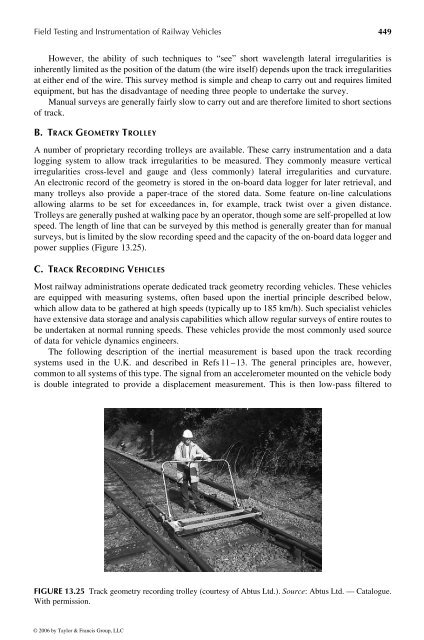You also want an ePaper? Increase the reach of your titles
YUMPU automatically turns print PDFs into web optimized ePapers that Google loves.
Field Testing and Instrumentation <strong>of</strong> <strong>Railway</strong> <strong>Vehicle</strong>s 449<br />
However, the ability <strong>of</strong> such techniques to “see” short wavelength lateral irregularities is<br />
inherently limited as the position <strong>of</strong> the datum (the wire itself) dependsupon the track irregularities<br />
at either end <strong>of</strong> the wire. This survey method is simple and cheap to carry out and requires limited<br />
equipment, but has the disadvantage <strong>of</strong> needing three people to undertake the survey.<br />
Manualsurveys are generally fairlyslow to carry out and are therefore limited to short sections<br />
<strong>of</strong> track.<br />
B. T RACK G EOMETRY T ROLLEY<br />
Anumber <strong>of</strong> proprietary recording trolleys are available. These carry instrumentation and adata<br />
logging system to allow track irregularities to be measured. They commonly measure vertical<br />
irregularities cross-level and gauge and (less commonly) lateral irregularities and curvature.<br />
An electronic record <strong>of</strong> the geometry is stored in the on-board data logger for later retrieval, and<br />
many trolleys also provide apaper-trace <strong>of</strong> the stored data. Some feature on-line calculations<br />
allowing alarms tobeset for exceedances in, for example, track twist over agiven distance.<br />
Trolleysare generally pushed at walking pace by an operator, thoughsome are self-propelled at low<br />
speed. The length <strong>of</strong> line that can be surveyed by this method is generally greater than for manual<br />
surveys, but is limited by the slow recording speed and the capacity <strong>of</strong> the on-board data logger and<br />
power supplies (Figure 13.25).<br />
C. T RACK R ECORDING V EHICLES<br />
Most railway administrations operate dedicated track geometry recording vehicles. These vehicles<br />
are equipped with measuring systems, <strong>of</strong>ten based upon the inertial principle described below,<br />
which allow data to be gathered athigh speeds (typically up to 185 km/h). Such specialistvehicles<br />
have extensive data storage and analysiscapabilities which allow regular surveys <strong>of</strong> entire routes to<br />
be undertaken at normal running speeds. These vehicles provide the most commonly used source<br />
<strong>of</strong> data for vehicle dynamics engineers.<br />
The following description <strong>of</strong> the inertial measurement is based upon the track recording<br />
systems used in the U.K. and described in Refs 11–13. The general principles are, however,<br />
common to all systems<strong>of</strong>this type. The signal from an accelerometer mounted on the vehicle body<br />
is double integrated to provide adisplacement measurement. This is then low-pass filtered to<br />
FIGURE 13.25 Track geometry recording trolley (courtesy <strong>of</strong> Abtus Ltd.). Source: Abtus Ltd. —Catalogue.<br />
With permission.<br />
© 2006 by Taylor & Francis Group, LLC









